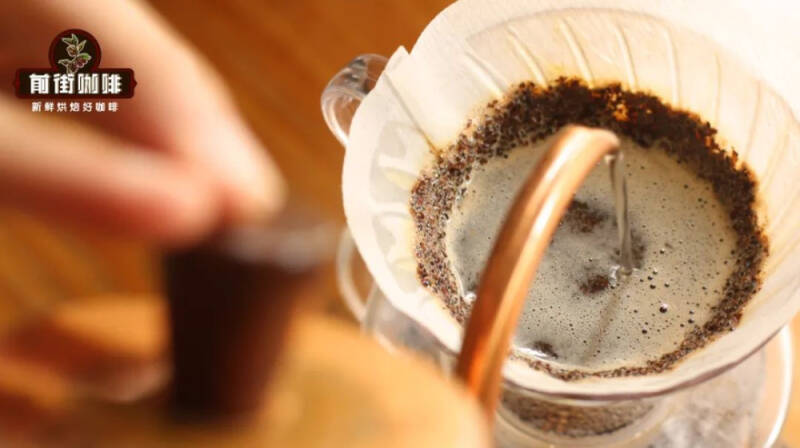What makes the V60 stand out among the many filter cups?

If you are a beginner coffee lover and ask an experienced person to recommend you a practical, easy-to-use and good-looking hand filter cup, there is a good chance that the other person will recommend you to buy a V60.
V60, a civilian filter cup that has been used by everyone, can be said to be one of the necessary instruments for every hand to play with the hands of the family. As a resident role produced by stores, Qianjie has to be used at least thousands of times a year, so it can be regarded as a "senior user" of V60. So, obviously there are so many types of filter cups on the market, why only the V60 has become a "heartthrob" in the handheld world?

Who invented V60? Hario, which designed V60 filter cup, was founded in Tokyo, Japan in 1921. It is a well-known local glassware manufacturer. It was originally devoted to the design and production of heat-resistant glass instruments and equipment in scientific research institutions. For example, the heat-resistant glass sharing pot often matched with hand-brewed coffee is a popular product of Hario.
In the 1940s and 1950s, Hario officially set foot in the field of household equipment, and the siphon pot was the first coffee extraction equipment they produced. At that time, slow soaking was the mainstream extraction form in the coffee market, such as Melitta filter cup, flannel filter screen, siphon pot, etc., either the pore size was too small, or the brewing steps were too cumbersome, and the time was generally too long. As a result, Hario hopes to create a brewing filter that is easy to operate and flows faster.
In 1964, Hario designers began using laboratory funnels to try to extract coffee, but it was not used for commercial use, and there are few records. In the 1980s, Hario developed a filter paper drip filter (similar in shape to Chemex, with a funnel-shaped filter connected to the lower half of the container), which was put into production in 1980.
In 2004, Hario redesigned the prototype of the V60 to make the filter more similar to what we are familiar with today, named for its unique 60 °cone angle and "V" shape, and officially went on sale a year later. On the HARIO website, we can find a prototype of the filter cup: a conical ceramic filter cup with 12 toothpicks neatly glued to simulate the drainage groove.
The extraction method of V60 filter cup 1. Compared with other filter cups, the conical and 60 °angle design allows the water to flow to the center and then drip into the pot when cooking with V60, extending the contact area between water and coffee powder, so that the aroma and taste can be fully extracted.
two。 Its iconic single large aperture allows the water to flow without any hindrance, and the liquid flow rate largely depends on the brewer's ability to control the flow, which is directly reflected in the coffee flavor. If your water injection habit is relatively large or urgent, and the extraction is over before the delicious substance is released from the coffee, the coffee taste is likely to be thin and light. Therefore, if you want to use V60 to make coffee with good flavor and high sweetness, you really need to practice and adjust the water injection technique in order to better express the sweet and sour balance of coffee.
3. On the side wall, the protruding ribs of spiral lines are long and short, running through the whole filter cup. On the one hand, it can prevent the filter paper from being closely attached to the filter cup, forming enough space for air circulation to meet the water absorption and expansion of coffee particles to the maximum extent; second, the design of the spirally convex groove also makes the falling water flow squeeze the powder layer to form a richer sense of layering, while prolonging the flow path to avoid insufficient extraction caused by large aperture.
What makes people pay attention to the V60 filter cup?
Before the millennium, the coffee market took medium and deep roasting as the mainstream baking direction, and the flavor direction of coffee brewing also advocated mellow, body fat, high sweetness, back sweet and other expressions, as well as caramelized flavors derived from deep roasting, such as chocolate, maple syrup, nuts, vanilla and so on. With the arrival of the third wave of coffee, people began to pursue regional flavors, such as the white flowers of Ethiopia and the sour berries of Kenya, the roasting of coffee changed from dark to light, and the taste taste changed from mellow and sweet to delicate sour.
Before the emergence of V60, the slow extraction method which tended to soak made the coffee flavor as a whole round, thick, balanced and sweet, but it was difficult to display the taste of some shallow roasted beans, such as flower and fruit aroma, light acid and so on. For example, the extraction of Melitta, KONO and other slow filter cups focuses on the rich flavor conditioning. The rapid extraction characteristics of V60 just make the coffee get more three-dimensional aroma and acid quality, so that some exquisite flavors can be presented.
It is also V60, which material is better to make coffee?
Nowadays, there are V60 filter cups of various materials on the market, including ceramic, glass, red copper, stainless steel and so on, in addition to the resin beloved in the front street. Each material not only affects the appearance and weight of the filter cup, but also produces subtle extraction differences in thermal conductivity during cooking, but the structural design remains the same.
The reason why Qianjie "only love" resin version of Hario V60, first of all, the resin material can effectively prevent heat loss. Secondly, in the standard industrial mass production, the resin material is the best molding product with the least error. Besides, who doesn't like a filter cup that doesn't break easily, right?
-END-
Front Street Cafe
No. 10 Baoqian street, Yandun road, Dongshankou, Yuexiu district, Guangzhou, Guangdong province
Important Notice :
前街咖啡 FrontStreet Coffee has moved to new addredd:
FrontStreet Coffee Address: 315,Donghua East Road,GuangZhou
Tel:020 38364473
- Prev

Where is the electric bean grinder better than the manual bean grinder? What should you pay attention to when grinding individual coffee beans?
In order to pursue long-term cooking stability, most friends will spend a lot of money to buy electric bean grinder (electric mill for short), the main reason is that they do not want to be bothered by too much fine powder in the hand bean mill! Secondly, the reason for buying electric mill is not only to ensure the stability of grinding quality, but also to make it easier.
- Next

Ethiopian Coffee producing area, Guji producing area, Sakui Coffee Development History, Sakui Coffee 7.0 introduction
When it comes to coffee, many people think of Ethiopia, the largest Arabica coffee producer in Africa with a long history. And there are many varieties of coffee. It is estimated that there are 10000 to 15000 varieties of coffee in Ethiopia today, and most of them have not yet been formally inherited.
Related
- Stop business for rectification! Jasmine milk white clerk deliberately did not pack and let the rider wait!
- Ridiculous! Tims pressured the federal government to relax the entry of foreign workers?!
- How to judge the brewing method by the state of the powder bed? How to break out of a deep hole with hand-brewed coffee?
- Detailed explanation of the proportion of gold gouache in hand-brewed coffee? What are the Gold Cup Guidelines?
- What is the difference between the gold label rose summer and the red label rose summer in Guixia Village? Are Rose Summer 1931 and Gori Rose Summer?
- Cudi stores ban other brands of coffee?! Netizen: No problem
- Is it better to make coffee cold or hot? Why is it recommended to drink hot coffee?
- Lucky people collapsed! The store ceiling is full of AI surveillance cameras?!
- Law Enforcement Bureau? Mixue Ice City enters Zhengzhou BRT platform!
- Heavy! Nestlé has been exposed to consider selling blue bottle coffee!

